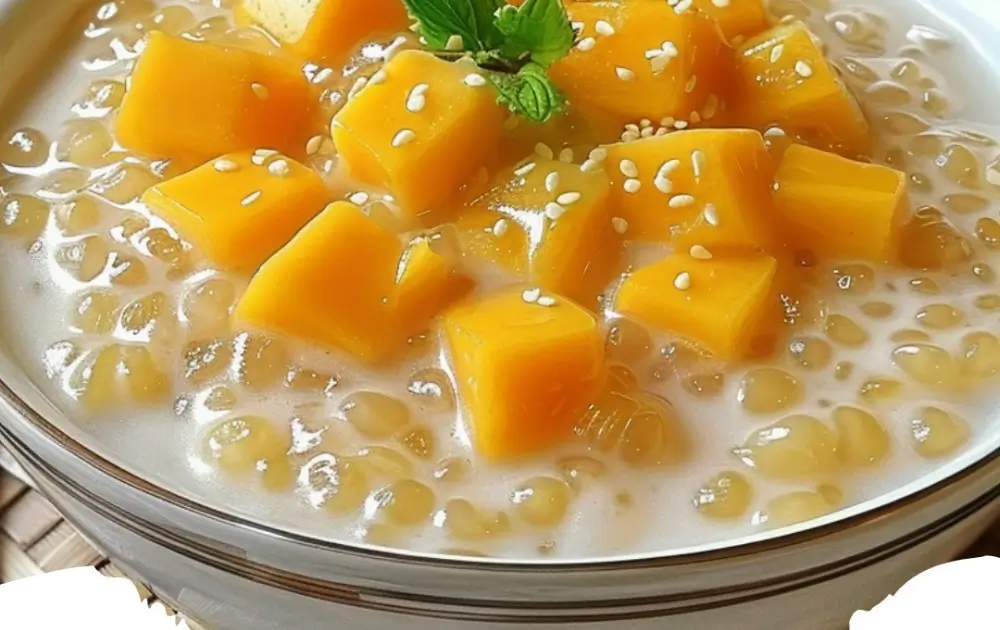Mango Sago is a vibrant, refreshing dessert that has captured the hearts of many around the globe. Originating from Hong Kong, this delightful treat blends the tropical sweetness of mangoes with the chewy, jelly-like texture of sago pearls. Over time, it has become a popular dessert across Southeast Asia, celebrated for its simplicity and versatility.
The Simple Yet Rich Ingredients
At its core, It requires only a few key ingredients: ripe mangoes, sago pearls, coconut milk or milk, and sugar to taste. Some variations might include additional components like pomelo segments or evaporated milk to enhance flavor and texture. The choice of mangoes plays a critical role in the dessert’s final taste, with sweeter varieties like Alphonso or Honey mangoes being highly preferred.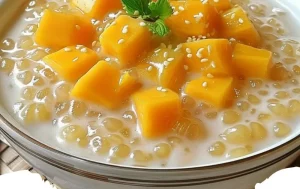
Preparing Mango Sago: A Step-by-Step Guide
Preparing this recipe involves several straightforward steps. First, you cook the sago pearls until they become translucent. Simultaneously, blend the mangoes into a smooth puree, reserving some chunks for garnishing. The cooked sago is then mixed with the mango puree, coconut milk, and sugar, adjusting the sweetness according to preference. This mixture can be served either chilled or at room temperature, often garnished with extra mango chunks to enhance its visual appeal and texture.
Customizing Your Mango Sago
One of the beauties of this recipe is its adaptability. For a richer texture, you can opt for full-fat coconut milk or even a combination of coconut milk and evaporated milk. Those looking for a lighter version might prefer using almond milk or low-fat milk. Additionally, the dessert can be adjusted to cater to different dietary needs by substituting sugar with alternative sweeteners or opting for vegan-friendly milk options.
Serving Suggestions and Pairings
The recipe is best served chilled, making it an excellent dessert for hot summer days. It can be enjoyed on its own or paired with other Southeast Asian sweets for a diverse dessert spread. To elevate the dining experience, consider serving Mango Sago in clear glasses, layering it with mango chunks and sago pearls to create a visually appealing presentation.
The Joy of Making Mango Sago
Making this recipe not only offers a delightful end to a meal but also an enjoyable culinary experience. The process of cooking sago, blending mangoes, and mixing them with creamy coconut milk is a therapeutic exercise that culminates in a dessert that’s as pleasing to make as it is to eat. Whether you’re a seasoned chef or a cooking novice, Mango Sago provides a simple yet satisfying project with deliciously sweet rewards.
Exploring Health Benefits and Variations
Beyond its delightful taste, Mango Sago serves up a range of health benefits, thanks to the mangoes at its heart. Mangoes are a rich source of vitamins A and C, antioxidants, and dietary fiber, contributing to improved digestion, a healthier immune system, and better eye health. Sago pearls, while more neutral in flavor, offer a boost of energy and can be a gluten-free carbohydrate source, making this dessert not only tasty but also a healthier alternative to many traditional sweets.
Innovative Twists on Traditional Mango Sago
For those looking to add a creative twist to traditional Mango Sago, the possibilities are endless. Introducing other tropical fruits like pineapple or banana can offer new layers of flavor and texture. Incorporating a splash of lime juice or zest into the mango puree introduces a tangy contrast that brightens the overall taste of the dessert. For an extra luxurious touch, a dollop of whipped cream or a sprinkle of toasted coconut flakes can add a delightful finish.
Making Mango Sago an Interactive Dessert Experience
Turning the preparation of Mango Sago into an interactive dessert experience can add an extra layer of enjoyment to dining. Serving the components separately and allowing guests to mix their own dessert bowls encourages participation and personalizes the eating experience. It’s a fun way to engage family and friends, especially during gatherings and special occasions.
The Global Appeal of Mango Sago
Mango Sago’s popularity transcends borders, showcasing the global appeal of this simple yet sophisticated dessert. Its presence in various forms across different cultures highlights its versatility and the universal love for mangoes. Restaurants worldwide have adopted and adapted Mango Sago, sometimes incorporating local ingredients or serving styles, further cementing its status as a beloved dessert across continents.
Embracing the Simplicity of Mango Sago
At its core, Mango Sago celebrates the simplicity of combining fresh ingredients to create a dessert that is both satisfying and refreshing. Its ease of preparation, coupled with the joy it brings to those who taste it, underscores the beauty of simple culinary creations. Whether enjoyed as a sweet end to a meal or as a cool treat on a warm day, Mango Sago remains a testament to the enduring appeal of combining simple ingredients with culinary creativity.
Celebrating Seasonal Mango Varieties with Mango Sago
Each season brings its own variety of mangoes, offering an opportunity to celebrate the diversity of this fruit through Mango Sago. Experimenting with different mango varieties can significantly alter the flavor profile and visual appeal of the dessert. From the deep sweetness of the Alphonso to the tangy zest of the Green Mango, seasonal selections invite a delightful exploration of tastes and textures, encouraging makers to tailor the dessert to the mangoes at hand.
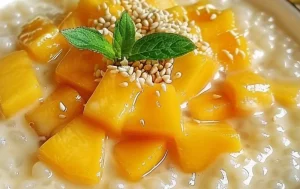
Pairing Mango Sago with Culinary Events
Mango Sago is not just a dessert; it’s a versatile dish that pairs well with various culinary events. For a summer barbecue, it offers a light, refreshing finish. During festive gatherings, it can serve as a sweet, communal dish that’s both elegant and comforting. Incorporating Mango Sago into themed dinner nights or as a palate cleanser in a multi-course meal showcases its flexibility and ability to complement a wide range of dishes.
Sustainability and Local Sourcing in Mango Sago Preparation
As the awareness of sustainability grows, so does the importance of using locally sourced and seasonal ingredients in dishes like Mango Sago. Opting for local mango varieties not only supports regional agriculture but also ensures the freshness and quality of the dessert. Additionally, using organic coconut milk and sustainably harvested sago pearls can enhance the environmental friendliness of this beloved dish.
Educational Opportunities in Making Mango Sago
Preparing this recipe also presents an excellent educational opportunity for cooks of all ages. It introduces younger chefs to basic cooking techniques like boiling and blending, while also teaching them about the cultural origins and variations of the dessert. For more experienced cooks, it offers a canvas for experimenting with flavor combinations and presentation techniques, further honing their culinary skills.
The Social Impact of Sharing Mango Sago
Sharing this recipe with family, friends, and communities does more than just spread culinary delight; it fosters connections and cultural exchange. This dessert has the power to bring people together, bridging differences over a shared love for sweet, creamy treats. By introducing others to Mango Sago, individuals can share a piece of their heritage or newfound culinary discoveries, enriching the social fabric through the universal language of food.
Incorporating Modern Techniques in Mango Sago Creation
The evolution of culinary arts has introduced a plethora of modern techniques that can elevate the traditional Mango Sago to new heights. Techniques such as sous vide for perfectly cooked sago pearls or using molecular gastronomy elements like mango foam can introduce a contemporary twist to this classic dessert. These innovations not only enhance the texture and flavor but also add an element of surprise and delight for those experiencing it in its new avatar.
Emphasizing Health-Conscious Variations
As people become more health-conscious, adapting Mango Sago recipes to fit dietary needs and preferences becomes essential. Creating sugar-free versions using natural sweeteners, or incorporating low-calorie alternatives like almond milk, allows individuals to enjoy this dessert without compromising on their health goals. This approach ensures that it remains a guilt-free pleasure for everyone, including those monitoring their sugar intake or following specific dietary regimes.
The Art of Presentation in Serving Mango Sago
The presentation of Mango Sago plays a significant role in its overall appeal. Employing artistic plating techniques, such as layering in clear glasses or garnishing with edible flowers, can transform this simple dessert into a visually stunning masterpiece. The art of presentation not only enhances the dining experience but also elevates the perceived value of the dish, making it a standout addition to any meal or occasion.
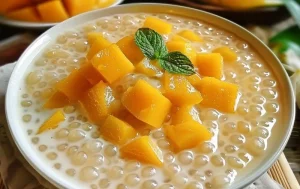
Fostering Innovation with Flavor Infusions
Exploring the infusion of new flavors into Mango Sago opens up a world of culinary creativity. Introducing exotic spices such as cardamom or a hint of chili can add an unexpected twist that tantalizes the taste buds. Infusing the coconut milk with lemongrass or pandan leaves before adding it to the dessert can impart a subtle yet distinctive flavor that sets your recipe apart from the traditional recipe.
Building Community Through Mango Sago Workshops
Organizing this recipe making workshops can be a fantastic way to build community and share knowledge. Such gatherings not only provide a platform for people to learn and try their hand at making this delightful dessert but also encourage the exchange of cultural stories and cooking tips. These workshops can serve as a melting pot of ideas, fostering a sense of community and shared enjoyment through the act of creating and savoring it together.
This recipe, with its simple elegance and rich cultural heritage, continues to charm and satisfy dessert lovers around the world. Through the exploration of new ingredients, techniques, and presentations, this classic dish remains relevant and exciting in the ever-evolving culinary landscape. Whether enjoyed in its traditional form or as a canvas for creative expression, it stands as a testament to the joy and unity that food can bring into our lives.
FAQs about Mango Sago
Can I use canned mangoes for Mango Sago? Yes, you can use canned mangoes if fresh ones are not available. Make sure to drain any syrup and rinse the mangoes before use to avoid excess sweetness.
Is there a substitute for sago pearls? Tapioca pearls are the closest substitute for sago pearls, offering a similar texture and appearance. Both need to be cooked until translucent before adding to the dessert.
Can Mango Sago be made vegan? Absolutely. To make Mango Sago vegan, simply use plant-based milk alternatives such as coconut milk or almond milk, and ensure that your sugar is vegan-friendly.
How long can I store it in the refrigerator? Mango Sago can be stored in an airtight container in the refrigerator for up to 3 days. Stir gently before serving, as the mixture may separate slightly over time.
Can I freeze it? Freezing is not recommended as it can alter the texture of the sago pearls and mangoes, making them less enjoyable upon thawing.
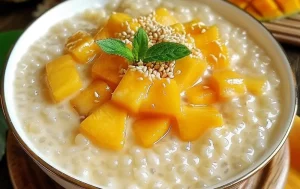
Conclusion
This recipe remains a beloved dessert for its refreshing taste, simplicity in preparation, and the joy it brings to those who partake in it. Whether you’re exploring its traditional roots or experimenting with modern twists, it offers endless possibilities for creativity and enjoyment. Its versatility in adapting to various dietary preferences makes it a universal favorite. Through the sharing of this delightful dish, we not only indulge in its sweet, creamy flavors but also in the rich cultural exchanges and communal experiences it fosters. It is more than just a dessert; it’s a celebration of culinary diversity and the pleasures of shared moments around the table.
Print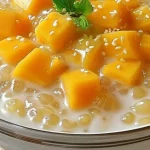
Mango Sago
- Author: recipstep
- Total Time: 35 minutes
- Yield: 4 servings
- Diet: Vegan
Description
Mango Sago is a refreshing and creamy dessert that combines the sweet, tropical flavor of mangoes with the soft, chewy texture of sago pearls, all blended in a rich coconut milk base. This dessert is perfect for cooling down on hot summer days or adding a sweet touch to any meal.
Ingredients
![]() 1 kilo Ripe mangoes
1 kilo Ripe mangoes
![]() 1 cup all purpose cream
1 cup all purpose cream
![]() 1 cup condensed milk
1 cup condensed milk
![]() 1 cup evaporated milk
1 cup evaporated milk
![]() 1 cup tapioca pearls (sago) uncooked
1 cup tapioca pearls (sago) uncooked
![]() 5 cup water (to cook the tapioca pearls)
5 cup water (to cook the tapioca pearls)
Instructions
Boil some water in a pot and place the tapioca pearls. Stir a bit to prevent from sticking together. Cover the pan and let it boil for 15 minutes using low heat.
To further cook the tapioca pearls and become transparent, add more water while stirring. Soak the tapioca pearls in water until ready to use.
Prepare your ripe mangoes. Slice the mango cheeks. Cut one mango into large cubes (for blending). Cut the rest of the mangoes in smaller cubes. Transfer the large and small cubes to separate plates.
In a blender, add the large mango cubes and half of the evaporated milk. Blend until smooth.
Drain the cooked tapioca pearls and transfer into a large bowl. Add the chopped mangoes, blended mangoes, the remaining evaporated milk, all purpose cream and the condensed milk. Mix gently until well-combined.
Chill the mango tapioca for at least 4 hours before serving. Once cool, serve the mango tapioca and enjoy!
Notes
- For a vegan version, ensure your sugar is vegan.
- Can be made ahead and stored in the refrigerator for up to 3 days.
- Sago pearls can be substituted with tapioca pearls if unavailable.
- Vegan (with vegan sugar), Gluten-Free
- Prep Time: 20 minutes
- Cook Time: 15 minutes
- Category: Dessert
- Method: Boiling, Blending
- Cuisine: Asian, Tropical
Nutrition
- Calories: 250
- Sugar: 18g
- Sodium: 15mg
- Fat: 15g
- Saturated Fat: 13g
- Carbohydrates: 30g
- Fiber: 2g
- Protein: 2g

